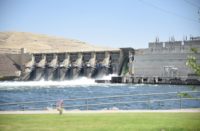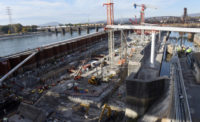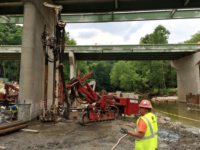A concept floated by Republican Mike Simpson, a U.S. congressman from Idaho, holds the potential to loosen the intractable logjam that has persisted for years among lawmakers, community members and federal officials to find a way to save the dwindling salmon population in the Columbia River Basin before it is too late.
Columbia tributary Snake River contains some of the best habitat for spawning and nurseries for salmon on their migration out and back from the Pacific Ocean. At one time, this area sustained about 50% of the Chinook salmon and steelhead trout in the entire Columbia River Basin. Now, all of the salmon and steelhead populations in the region face potential extinction. Conservation groups and wildlife experts say hydroelectric dams are the culprit because they interrupt the normal migratory path for fish and raise water temperatures to uninhabitable levels.

Simpson’s plan, released on his website Feb. 5, would provide $33.5 billion to breach four of the working hydroelectric dams on the lower Snake River in the Columbia River Basin. Included in that number would be $10 billion in direct funding to the Bonneville Power Administration to replace the roughly 1,000 MW of electricity that would be lost by demolishing the dams.
Simpson says he hopes to introduce legislation implementing his ideas—potentially as part of an infrastructure stimulus package that the Biden administration is expected to propose in coming months—to resolve a situation that he calls “unsustainable.” The debate has looked at the issue as an either-or situation—dams or wildlife—when the answer may lie in a more nuanced approach, he says. “The Northwest seems to be caught in a status quo of fighting over salmon and the four Lower Snake River dams. … Either the salmon will go extinct or the courts or some other body will step in and take drastic unilateral action.”
He adds: “The question I am asking the Northwest delegation, governors, tribes and stakeholders is, ‘Do we want to roll up our sleeves and come together to find a solution?’ ”
Simpson’s concept has generated a groundswell of discussion in the region, but whether it will translate to tangible action is unclear. He has caught the attention of many of the people and interests who often find themselves on opposite sides of the debate. Kurt Miller, executive director of Northwest River Partners, an organization representing community-owned utilities in the Pacific Northwest, says that although his group is generally reluctant to even discuss removing dams that are still operating efficiently and providing benefit to the community, Simpson “is very clear—both in his statements and in the dollars associated with the concept that the dams are very valuable to the region … That acknowledgement allows us to have an honest conversation about the future.”
Conservation, tribal and sporting groups have come out in strong support of Simpson’s concept. Todd True, a senior attorney for Earthjustice, describes Simpson’s proposal as a “bold vision.” True says, “It will be a heavy lift, but if we all work together, I think we can do it.”
But so far, Simpson’s colleagues have been circumspect, or flat-out opposed. In a Feb. 5 press release, Rep. Cathy McMorris Rodgers (R-Wash.) said, “These dams are the heart of Eastern Washington. Spending $33 billion to breach them—with no guarantee that doing so will restore salmon populations—is a drastic, fiscally irresponsible leap to take.”
And the response has been tepid even from Democratic lawmakers in the region. The four regional senators who would be most involved with developing an infrastructure package, the most likely vehicle for Simpson’s proposal, urged caution.
Maria Cantwell and Patty Murray of Washington, and Ron Wyden and Jeff Merkley of Oregon said in a joint statement: “All communities in the Columbia River Basin and beyond should be heard in efforts to recover the Northwest’s iconic salmon runs while ensuring economic vitality of the region. Any process needs to balance the needs of communities in the Columbia River Basin, be transparent, be driven by stakeholders and follow the science.” Simpson will need support from at least some of these Democrats.
Conservation and fishing groups have long advocated for the removal of the four dams along the lower Snake River, built in the 1960s and 1970s. They say removing the dams would reduce the dangerously high temperatures for various fish species and remove a major impediment to natural fish spawning and migration cycles. Jacqueline Koch, a regional communications manager at the National Wildlife Federation, says, “Over 20 years, we’ve spent more than $17 billion on habitat restoration. But in that time, we’ve not been able to get even one of the 13 [endangered] fish populations delisted. When you look at that, it begs the question—are these mitigation measures working?”
The Problem
Environmental groups say the dams have interrupted the normal migration path of salmon and created shallow conditions behind the reservoirs that heat water to temperatures as high as 68° F, too warm for fish to survive. Koch says the dams essentially have destroyed the conditions salmon need to survive. “You’ve taken a free-flowing river with cool water running through it quickly,” and replaced it with a dam system that not only slows passage, but also creates shallow slat pools that quickly heat to dangerously high levels, she says. In 2015, some 250,000 sockeye died as a result of a spike in temperatures.
In May 2020, the U.S. Environmental Protection Agency issued a Total Maximum Daily Load (TMDL) for the Columbia and Snake Rivers that established a temperature threshold for water quality standards under the Clean Water Act, which Washington state and Oregon have already incorporated into their Clean Water Act permitting framework, or plan to. “There is a direct mechanism to bring these temperature effects under regulation,” says Miles Johnson, a senior attorney at Columbia Riverkeeper. As a result, the Corps will be pressed to find a solution to mitigate the temperatures, he says, or face legal challenges down the road.
The Army Corps Approach
The U.S. Army Corps of Engineers has traditionally included mitigation efforts to restore fish habitats in the basin and to make it easier for salmon to spawn and migrate. In its latest Environmental Impact Statement, released in August 2020, the Corps selected leaving the dams intact but intensifying mitigation efforts.
“It will be a heavy lift, but if we all work together, I think we can do it.”
—Todd True, Earthjustice
Matt Rabe, director of public affairs for the Corps of Engineers’ Northwest division, said in an email to ENR, “The recently completed environmental impact statement took a comprehensive look at all aspects of the Columbia River System of 14 dams and found we can operate these multiuse facilities while still providing safe, effective passage for both juvenile and adult salmon.”
John Eisenhauer, former commander for the U.S. Army Corps of Engineer’s Portland District and now at Dawson & Associates, a consulting firm focused on water resource policy, says the problem is complex, and that there is no silver bullet. Breaching a dam is a significant undertaking with potential negative effects on the local and regional economy, agricultural and transportation capabilities, and the reliability of a steady power supply.
All of those concerns need to be balanced with the desire to provide a habitat that is hospitable to salmon and other fish populations, he says.
When the Corps conducts an EIS, they are looking at a project’s impacts related to the national interest, not simply local or regional impacts, Eisenhauer says. “When you look at something as significant as breaching those dams, and then the secondary and tertiary aspects of it, when there is no guarantee of success,” other options might be more viable.






